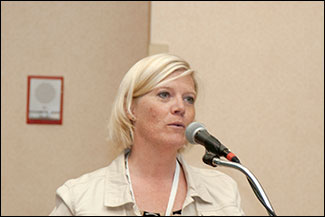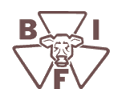Nutrition’s Effects on
Developmental Programming
A look at the long-lasting impact of nutrition on embryos.
by Kasey Brown, associate editor, Angus Journal®
LINCOLN, Neb. (June 19, 2014) — What the cow eats while she’s pregnant can affect the performance of her calf, a phenomenon often called developmental programming, explained Kim Vonnahme, associate professor of animal science at North Dakota State University. She spoke to attendees of the 2014 Beef Improvement Federation (BIF) Research Symposium & Annual Meeting in Lincoln, Neb., June 18-21.

On the female side, Kim Vonnahme, associate professor of animal science at North Dakota State University, noted that a higher percentage of heifers born to dams who received protein supplementation calved in the first 21 days and had an increased overall pregnancy rate.
She explained that developmental programming is the effect of a stimulus or insult that establishes a permanent response to the phenotype. The phenotype equals the genotype plus the environment. The hypothesis behind developmental programming is that exposure during a critical period in development may influence later metabolic or physiological functions in adult life. Simply put, management changes during certain stages in pregnancy can affect the calf.
She illustrated examples that steers with dams supplemented with protein late in the pregnancy had heavier live weights and heavier hot carcass weights. Additionally, a higher percentage of those steers graded Choice.
On the female side, Vonnahme noted that a higher percentage of heifers born to dams who received protein supplementation calved in the first 21 days and had an increased overall pregnancy rate.
The placenta plays a huge role in fetal growth. Nutrition of the dam affects the blood flow to the fetus, she explained. In a study looking at how nutrient restriction affects blood flow to the uterus, there was no alteration in blood flow until day 140, and then compensatory blood flow was observed. In tests with nutrient restriction early in the pregnancy, not much restriction of blood flow was observed. However, when the nutrients were restricted later in the pregnancy, blood flow was also restricted.
“The timing of the restriction affects placenta function,” Vonnahme said.
The placenta is adaptable and has a great ability to compensate. Future work will look at maternal intake and efficiencies, timing of supplementation and specific components of the diet.
Developmental programming isn’t just on the dam side, Vonnahme noted. Sires can impact fetal development, though research is lacking in livestock.
The 2014 BIF Annual Meeting & Research Symposium was hosted by the University of Nebraska–Lincoln, the U.S. Meat Animal Research Center and the Nebraska Cattlemen June 18-21 in Lincoln, Neb. The Angus Journal and LiveAuctions.tv provide comprehensive online coverage of the event at www.BIFconference.com. Visit the Newsroom for summaries, proceedings, PowerPoints and audio of the sessions; the Awards page for announcements of award winners; and the Photos page for galleries of photos from the meeting and the tours.
Editor’s Note: This summary was written under contract or by staff of the Angus Journal.Through an agreement with the Beef Improvement Federation, we are encouraging reprinting of the articles to those who will adhere to the reprint guidelines available on this site. Please review those guidelines or contact Shauna Rose Hermel, editor, at 816-383-5270. PowerPoints are posted with permission of the presenter and may not be reproduced in whole or in part without the express permission of the presenter.
API's coverage of the event is made possible through collaboration with BIF and sponsorship of LiveAuctions.tv. For questions about this site, or to notify us of broken links, click here.
Headquartered in Saint Joseph, Mo., API publishes the Angus Journal, the Angus Beef Bulletin, the Angus Beef Bulletin EXTRA, and the Angus Journal Daily, as well as providing online coverage of events and topics pertinent to cattlemen through the Angus Journal Virtual Library.



